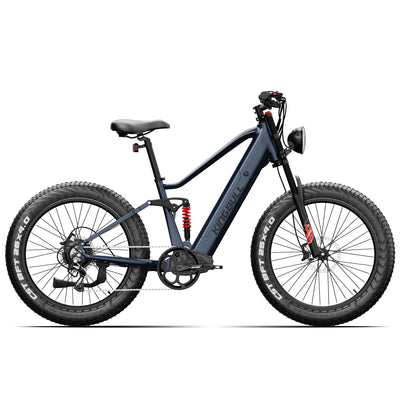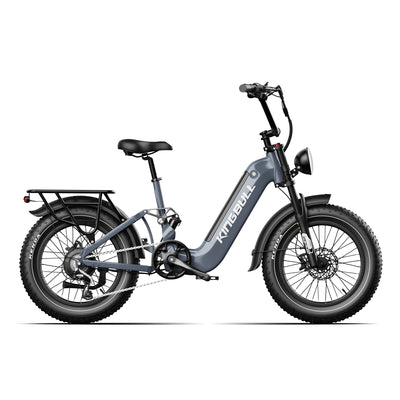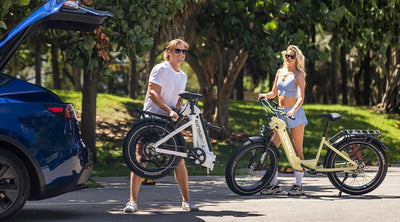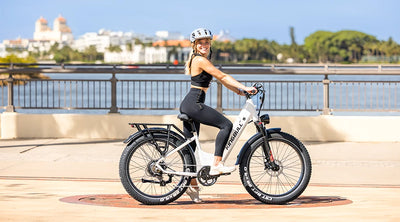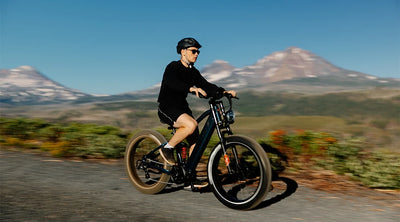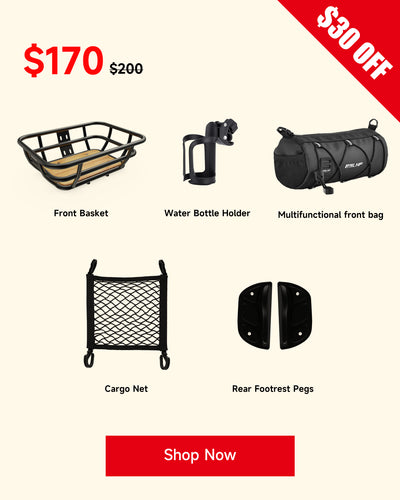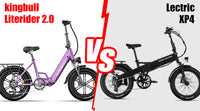Explore News

Tips & Cycling Knowledge
What Affects Electric Bike Speed Limits?
Why Are Electric Bikes Speed-Limited?
Electric bikes in the U.S. are distinct from other vehicles, primarily in terms of performance and regulations. Federal laws set the following requirements for e-bikes:
Motor power must be 750 watts or less.
Pedals are required for rider control.
The top motor-assisted speed is capped at 20 mph.
Riders can exceed 20 mph by pedaling or downhill riding, but the motor assistance stops at this limit. When going downhill, e-bike speeds may surpass the standard limit, but only due to pedal power or gravity. This design ensures e-bike safety and keeps usage consistent across various riding scenarios.
Why Set a Speed Limit?
E-bikes that meet these federal requirements can legally operate on most roads, lanes, and designated bike paths. While some models are built to exceed 20 mph, they're typically for off-road use. On public roads, exceeding speed limits can lead to violations. Some high-speed e-bikes available online are geared toward specialized or off-road use and are not intended for regular commuting.
In the U.S., a 20 mph speed limit is fairly generous. By comparison, European countries set a lower limit at 15 mph. Since average cyclists often don’t exceed 12 mph, the 20 mph cap for e-bikes is reasonably high.
E-Bike Speed Limit Categories
In the U.S., e-bikes are classified into three main types based on control, speed, and power:
Class 1: Pedal-assist only, providing motor support as the rider pedals, with a max assisted speed of 20 mph and up to 750 watts of power. This type is ideal for battery efficiency and extended range.
Class 2: Throttle-controlled, where the rider can use a throttle for direct electric power up to 20 mph. Unlike Class 1, this class allows full acceleration without pedaling.
Class 3: Higher motor support with a speed cap of 28 mph and usually equipped with a 750W motor. Depending on the regulations in different states, there may be age restrictions on the use of Class 3 e-bikes..
What Influences E-Bike Speed?
E-bike speed isn't just about legal caps; other factors play a role too:
Motor PowerMotor wattage is crucial. Higher wattage delivers more power, enhancing acceleration and quick-start performance. For example, a 750W motor offers stronger acceleration, especially useful for reaching higher speeds in a short time. Lower-wattage motors are more energy-efficient, ideal for city commuting and smooth rides.
Rider and Bike WeightCombined rider and bike weight affects speed and range. Heavier loads demand more motor power, which can lower speed potential.
Battery ChargeE-bikes perform best with a fully charged battery. As the battery drains, power output may reduce, affecting top speed. Many e-bikes automatically limit power at low battery levels to preserve range.
Terrain and Road ConditionsSpeed varies with terrain. Flat roads allow higher speeds, while gravel paths or steep inclines may require more effort to maintain speed. Downhill slopes, thanks to gravity, will naturally speed things up.
Weather and Environmental FactorsWeather can impact speed too. Headwinds create resistance, slowing down the ride, while tailwinds can boost speed. Extreme temperatures can affect battery performance, indirectly influencing speed.
Why Following Riding Regulations is Essential
E-bikes generally reach higher speeds than traditional bikes, so laws and speed limits are set to reduce accident risks and protect e-bike riders. Most regions ensure that e-bikes cut motor support upon reaching speed limits, leaving only pedal power to maintain momentum. These laws exist to keep e-bike riding safe and prevent potential traffic incidents.
Conclusion
Electric bikes are an ideal option for those seeking an efficient and easy riding experience, helping riders conserve energy while boosting enjlso important to follow regulations for safety. Higher speeds can increase risk, so choosing the right e-bike and operating it within safe limits is essential.
Read more

Tips & Cycling Knowledge
Adjusting Class 3 E-Bikes to Class 2: A Comprehensive Guide
As electric bicycles become more popular, more people are paying attention to the characteristics and suitable scenarios of different types of e-bikes. Electric bicycles are categorized into three classes, each with its own unique features and legal regulations. This article will provide a detailed overview of the differences among these three classes of electric bicycles and offer specific methods for adjusting the Kingbull Class 3 e-bike to Class 2.
The difference between the three types of electric bicycles
Class 1 Electric Bicycles:
Assistance Mode: The motor provides assistance only when the rider is pedaling.
Speed Limit: Maximum speed is 20 mph (approximately 32 km/h).
Class 2 Electric Bicycles:
Assistance Mode: Provides assistance while pedaling and can also be powered by a throttle.
Speed Limit: Also has a maximum speed of 20 mph (approximately 32 km/h).
Class 3 Electric Bicycles:
Assistance Mode: The motor provides assistance only when the rider is pedaling and cannot be operated solely by a throttle.
Speed Limit: Maximum speed is 28 mph (approximately 45 km/h).
How to Adjust Kingbull Class 3 E-Bike to Class 2
To adjust your Kingbull Class 3 e-bike to comply with Class 2 standards, follow these simple steps:
Access the Settings Menu:
Long press and hold the “+” and “-” buttons simultaneously to enter the display settings page.
Navigate to P08:
Shortly press the power button until you reach the P08 setting.
Adjust the Speed Limit:
Set the speed limit to approximately 31-32 km/h (about 19-20 mph). This adjustment ensures that the maximum speed of your e-bike does not reach 28 mph.
Save the Settings:
After making the adjustment, long press and hold the “+” and “-” buttons again to save the settings.
Check the Maximum Speed:
To verify the adjustment, tilt the bike to lift the rear wheel off the ground. Use the throttle to check that the maximum speed does not exceed 20 mph.
Further Speed Reduction (if needed):
If you need to lower the maximum speed further, you can adjust the speed limit within the range of 10-41 km/h:
10 km/h ≈ 6.2 mph
20 km/h ≈ 12.4 mph
30 km/h ≈ 18.6 mph
Conclusion
By understanding the characteristics of different types of electric bicycles and the specific adjustment methods, you can better choose the riding style that suits you and enjoy the experience. Always adhere to local laws and regulations when making any adjustments to ensure safety and compliance. We hope this guide helps you successfully adjust your electric bicycle, enhancing your riding enjoyment!
Read more

Tips & Cycling Knowledge
Essential Winter Gear for Your Electric Bike: Ride in Style and Comfort!
When winter rolls in, many people tuck their bikes away until spring. But not you! You know that riding an electric bike in winter can be a fantastic experience—if you have the right gear. Whether it’s the crisp air or the magical winter landscapes, cycling in colder weather can be exhilarating. To help you embrace the season, we’ve put together a list of must-have winter tools and accessories that will keep you warm, safe, and stylish on your electric bike.
1. Windproof Gloves: Keep Your Fingers Toasty
Nothing ruins a good ride faster than cold hands. Our windproof gloves are not just your average winter mitts; they’re designed to keep your fingers warm while still allowing you to grip the handlebars like a pro. Say goodbye to frozen digits and hello to comfortable riding!
2. Winter Ear Protection Baseball Caps: Warmth and Style Combined
With the biting winter cold, you need extra protection for your ears! Our Winter Ear Protection Baseball Caps are the perfect choice for cyclists. This cap not only provides excellent wind protection for your ears, but also boasts a stylish design, keeping you warm and looking cool during your ride. Whether you're commuting around town or embarking on a long adventure, this cap will complement your winter cycling gear perfectly.
3. Windproof Helmet: Safety Meets Warmth
Your safety is our priority, and our windproof helmets have you covered—literally! With a snug fit and insulation, these helmets keep your head warm without sacrificing safety. Plus, they look pretty snazzy too!
4. Slip-Resistant Tires: Grip It and Rip It
Winter roads can be slippery, but with our electric bikes, you’re in good hands. Every model comes equipped with slip-resistant tires, designed for maximum grip on icy surfaces. You’ll feel confident tackling any winter path that comes your way!
5. Fenders: Keep the Gunk at Bay
Mud, slush, and snow? No thanks! Our electric bikes come with built-in fenders to keep you clean and dry while you ride. Say goodbye to unsightly splashes and hello to a more enjoyable winter adventure.
6. Bike Cover: Protect Your Ride
When you're not out riding, make sure your bike is safe from the elements with our stylish bike cover. It’s like a cozy blanket for your electric bike, shielding it from rain, snow, and frost, so it’s ready to roll whenever you are.
7. Phone Mount: Navigate Like a Pro
Getting lost in the winter wonderland is fun—unless you have to be somewhere. Our phone mount keeps your device secure on your handlebars, making it easy to navigate and stay connected. No more fumbling with maps in the cold!
8. Face Mask: Breathe Easy
Keep your face warm and toasty with our breathable face mask. Designed to block out the wind while allowing airflow, it’s a perfect addition to your winter riding gear. You’ll stay warm and look cool at the same time!
9. Polarized Sunglasses: See Clearly
Winter sun can be blinding, especially when it reflects off the snow. Our polarized sunglasses cut through the glare, giving you crystal-clear vision on your rides. Plus, they add a touch of style to your winter look!
Wrap-Up
Don’t let winter stop you from enjoying the great outdoors! With our collection of winter essentials—like windproof gloves, slip-resistant tires, and snazzy helmets—you can tackle the chilly season with confidence and flair. So gear up, get out there, and embrace the magic of winter cycling! Who knows what adventures await? Happy riding!
Read more
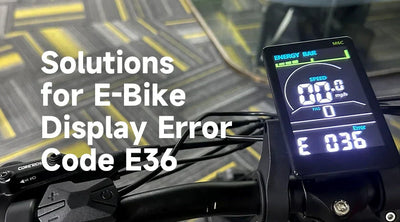
MaintenanceTips & Cycling Knowledge
E-Bike Display Error Codes: Solutions for Error Code E36
The display screen of an electric bicycle (e-bike) is not only an essential source of information during a ride but also shows key data such as speed, battery level, mileage, and riding mode. This information helps riders better understand the status of their bike, ensuring a smooth and safe riding experience. However, beyond these functions, the display screen has another crucial role: when a fault occurs, it can display specific error codes that inform the rider about potential issues with the e-bike.
Different error codes correspond to various types of faults, which may involve the motor, controller, braking system, or sensors, among other components. These error codes function as the e-bike’s “diagnostic tool,” helping riders quickly identify the root cause of the problem. Therefore, when an error code appears on the e-bike’s display, the rider must use the code’s meaning to conduct a thorough inspection of the bike and take appropriate measures to resolve the issue.
Understanding Error Code E36
Error code E36 typically indicates an issue with the electric bike's motor or that the controller has detected a voltage beyond the safe operating range. This can be caused by several factors, including:
Loose or Damaged Cables: The motor cables under the frame may be loose, broken or have poor contact, affecting power output.
Display Malfunction: The bike's display could be faulty, misinterpreting or incorrectly communicating voltage levels to the controller.
Controller Fault: The voltage detection circuit within the controller may be malfunctioning, preventing accurate transmission of voltage data, or leading to an incorrect detection of over/under-voltage conditions.
Motor Malfunction: The motor may be damaged, resulting in improper function, and might need replacement.
How to Respond to Error Code Alerts
When an error code appears on your e-bike’s display, there’s no need to panic. Most issues can be addressed through basic checks and troubleshooting. Here are some general steps to follow:
1. Check Connections and Plugs
Many fault codes stem from loose connections or damaged wires. Carefully inspect the connections of various components on your electric bike, paying special attention to the motor cables, particularly when an E36 code appears, as this is often caused by issues with the motor or motor control circuit. Check for any looseness, wear, or breakage in the motor wires, especially at the connection point under the frame.
Corrosion on Plugs: Due to moisture or dirt, plugs may corrode over time. Regularly clean the plugs and ensure they are dry.
2. Reset the Display
Sometimes, the bike’s display may need to be reset to clear temporary faults. Follow these steps to reset the display:
Enter Settings Mode: Press and hold the “+” and “-” buttons simultaneously to access the display settings menu.
Select P16 Parameter: Press the power button to navigate to the P16 parameter setting.
Reset the Display: In the P16 parameter screen, press and hold the “-” button for about five seconds to reset the display.
Save Settings: Once reset, press and hold the “+” and “-” buttons again to exit settings, then restart the display to check if the fault has been cleared.
3. Check the Controller
If the problem persists after resetting the display and inspecting the cables, it may be related to a fault in the controller. Verify that the connections between the controller and other components (like the motor and sensors) are secure and that the controller itself is functioning correctly.
For Literider models, the controller is located inside the fold of the frame. In Voyager, Rover, Hunter, and Discover models, the controller is situated near the pedals and crank. You’ll need to remove the black cover to check the controller. You can refer to these videos for guidance on how to perform this check.
4. Contact Professional Support
If you are unsure how to proceed or if the issue remains unresolved after the above steps, please contact our customer service at customers@kingbullbike.com.
To expedite the resolution of your issue, please include your order number along with any relevant images or videos of the problem. Our customer service team will respond within 48 hours with more specialized technical support.
If you encounter other fault codes E34 or E37, please click here to view the solution steps.
Conclusion
Troubleshooting E-bike error code E36 faults often involves checking connections, resetting the display, and inspecting the controller. By following these steps, common issues can be resolved. However, if problems persist, reaching out to professional support with detailed information will ensure timely assistance. Remember, regular maintenance is key to keeping your e-bike running smoothly and preventing future faults.
Read more

Tips & Cycling Knowledge
The Best Bikepacking Route for Fall and Winter: Baja Divide
The Baja Divide is a stunning route that stretches between the Pacific Ocean and the Sea of Cortez, passing through historic Spanish mission sites, shaded oases with plenty of water, remote ranches and fishing villages, bustling highway towns, and every major mountain range in Baja California. This route, made up of miles of beautiful desert tracks, is the perfect destination for bikepacking during the fall and winter.
The complete route is about 3473 miles, and divided into 20 individual segments, defined by resupply points.
If you're choose one segment to enjoy the freedom of cycling while easily tackling rugged terrain, the Kingbull Literider folding electric bike is your ideal companion. With its powerful 750W motor, portable folding design, and comfortable riding experience, Literider helps you conquer any terrain with ease while offering impressive range, so you can focus on the scenic beauty without worrying about fatigue on long rides.
Baja California and Baja California Sur are two of the least populated areas in Mexico, particularly away from the border regions near Tijuana and Mexicali. Vast deserts, rugged coastlines, and a taste of the wild west make this a prime destination for those seeking adventure and natural beauty.
Route Features
Throughout the Baja Divide, you'll find numerous dirt roads that cut through fishing villages and ranches. However, some parts of the route receive little maintenance and are often affected by weather. Mountain roads are rugged, and sandy tracks add to the challenge. Plus bikes with 3.0” tires are recommended for navigating the sand. Tubeless tires are essential to avoid cactus thorns.
The rhythm of life on the Baja Divide revolves around cycling, camping, and resupplying. Wild camping is a highlight of this route, and while resources are limited, the route is designed with enough resupply points to make a self-supported tour feasible. On some sections, you may need to carry 2-3 days of food and 10-12 liters of water. Fortunately, with an electric bike like the Kingbull Literider, you'll have the added power and range to lighten your load and make your journey more enjoyable.
Best Riding Time
The best time to ride the Baja Divide is during winter, particularly from November to March. The dry, warm climate is ideal for riding, while summer temperatures can be extreme, and late summer to fall brings hurricane season.
Cultural and Culinary Experience
Along the Baja Divide, you'll experience a mix of rural and urban life, as well as diverse landscapes. The route passes several historic Spanish mission sites, often located near water and shaded by date palms, offering a perfect blend of history and nature. You’ll also pass through bustling highway towns like Colonet, Vincente Guerrero, Vizcaíno, and Ciudad Constitución, where you can sample delicious Mexican food such as tacos, ceviche, and fresh pastries.
Scenery and Camping
The scenery along the Baja Divide is breathtaking, with deserts, canyons, towering cacti, cirios trees, and mountain ranges dominating the landscape. The Sea of Cortez offers stunning views where the desert meets the sea. If you're willing to carry extra food and water, you can also enjoy remote beach camping at some of the secluded beaches along the route.
Practical Information
Navigation: Since most roads along the Baja Divide are unmarked and unnamed, GPS navigation is highly recommended.
Equipment: Wide tires (at least 3.0”) and a tubeless tire system are essential.
Supplies and Water: On certain stretches, you may need to carry up to 10 liters of water and plan ahead, especially in areas without ATMs like Cataviña, Bahía de los Ángeles, and San Ignacio.
Visa Information: Most travelers from the U.S., Canada, Australia, the EU, and South American countries can enter Mexico visa-free for up to 180 days. However, for stays longer than 7 days, a tourist visa fee of around $20 is required at the border, along with a passport.
Conclusion
If you love wilderness adventures and are seeking a winter escape, the Baja Divide is an outstanding choice. With vast deserts, historical mission sites, rugged coastlines, and the welcoming culture of Mexico, this route will leave you with unforgettable memories. Go light, embrace nature, and with a bike like the Kingbull Literider, you'll enjoy the ride with extra power and less worry.
Read more

Purchase GuideTips & Cycling Knowledge
Discover the Future of Off-Road Riding: The Magic of the Four-Bar Suspension System
When it comes to adventure and freedom on two wheels, off-road electric bikes have taken the spotlight. Whether you're navigating through rugged trails or conquering steep hills, comfort and stability are key to a thrilling ride. Today, we’re shining a light on the unsung hero of your riding experience—the four-bar suspension system.
What is a Four-Bar Suspension System?
Imagine tearing through bumpy terrain, with the four-bar suspension working like a trusty sidekick, perfectly smoothing out every jolt. This advanced suspension design features four flexible links that distribute impact forces effectively, allowing you to glide over rough patches as if you were cruising on smooth pavement.
The Secret to a Comfortable Ride
Riding is no longer a battle against bumps. The four-bar system optimizes tire contact with the ground, significantly reducing vibrations. As you race through mountain trails or explore sandy paths, you'll hardly notice the small bumps and dips. It’s all about “easy riding, pure enjoyment”!
Unmatched Control and Handling
But the four-bar suspension isn’t just about comfort; it’s also about enhancing your control. When you hit those sharp turns, the improved tire grip gives you the confidence to tackle any challenge. Whether you're speeding down steep slopes or maneuvering through muddy paths, you’ll feel a sense of stability and precision, like having an extra pair of hands guiding you through every twist and turn.
Advantages Over Traditional Systems
Compared to traditional fork and rear shock designs, the four-bar suspension truly shines. Its complex structure may seem daunting, but it translates into superior suspension performance. Riders can easily adjust the shock travel for different terrains, providing a customized riding experience. Looking to maximize your fun on the trails? The four-bar system is your ticket to adventure.
Real Riders, Real Experiences
Our customers who ride bikes equipped with the four-bar suspension system have shared that their experiences have transformed dramatically. From reaching challenging mountain tops to cruising along picturesque forest trails, this system empowers them to explore freely without worrying about the rough terrain.
Conclusion
The four-bar suspension system is a revolutionary feature in off-road electric bikes. It not only enhances your comfort and stability but also brings an unmatched joy to your rides. So, on your next adventure, choose an electric bike with a four-bar suspension and turn every ride into an unforgettable journey.
Are you ready to embrace a new riding experience? Let’s hit the trails together and uncover the beauty of exploration!
Read more




